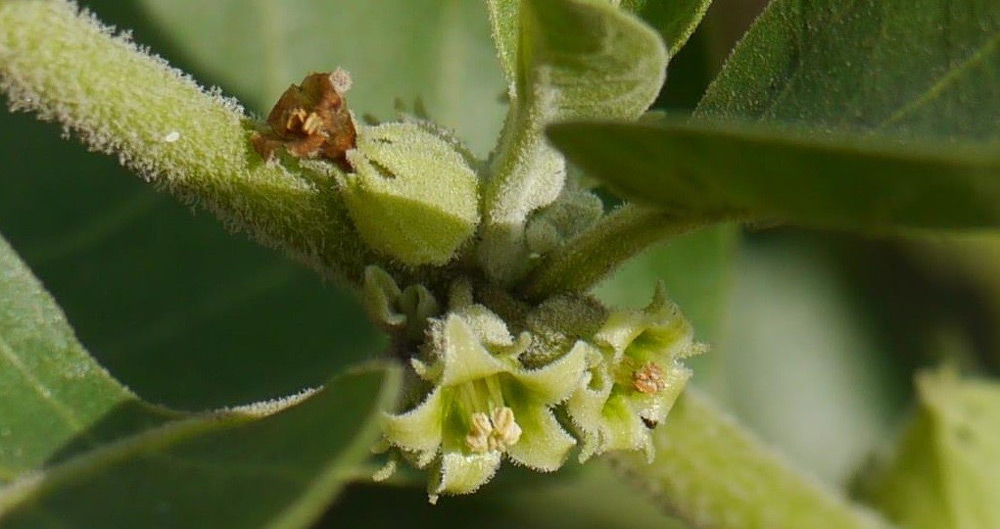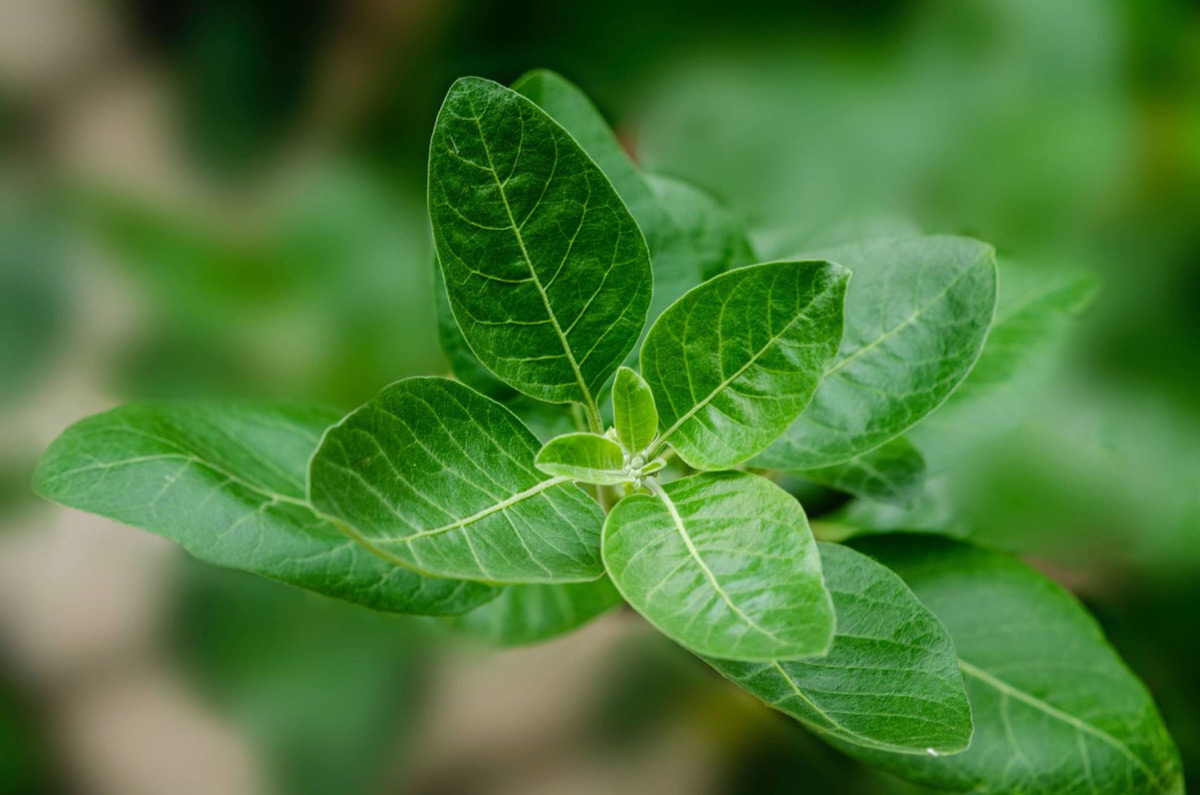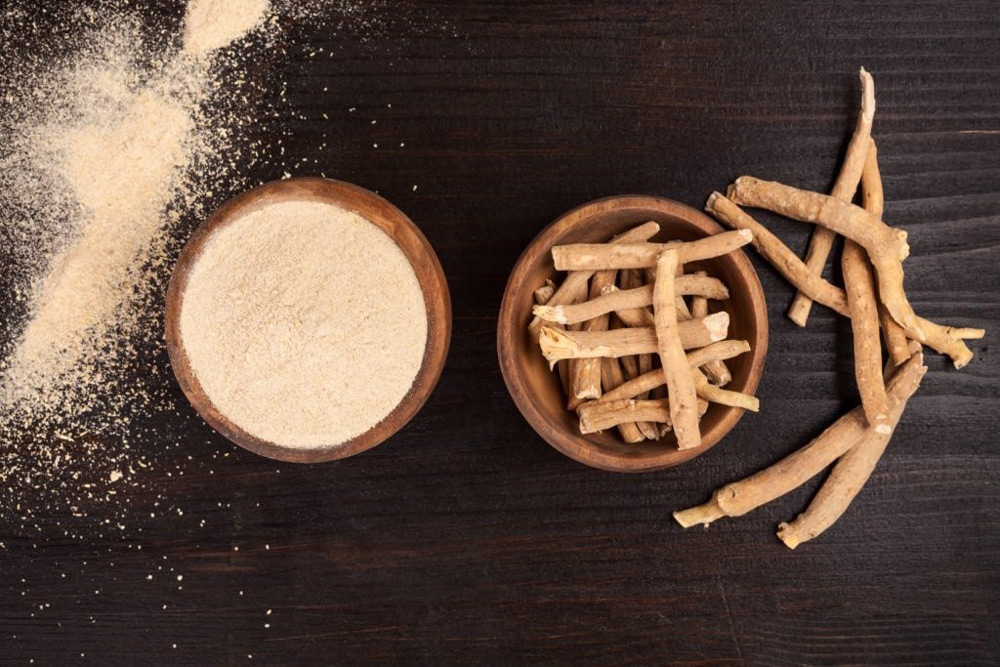Withania samnifera (WS), also known as ashwagandha, it has been an evergreen shrub. Ashwagandha (Withania somnifera, fam. Solanaceae) is commonly known as “Indian Winter cherry” or “Indian Ginseng”.
Withania somnifera:
Ashwagandha, scientifically known as Withania somnifera Dunal, is an important medicinal plant in the Ayurvedic system of medicine. The roots are highly valued, and are used either alone or in combination with other medicinal plants to treat a variety of ailments. It is also used as a general tonic to increase and to improve overall health and longevity. Regular consumption of ashwagandha is believed to prevent diseases in individuals of different ages and with various health conditions.
the Ayurvedic system:
Ayurveda, a natural system of medicine, originated in India more than 3,000 years ago. The term Ayurveda is derived from the Sanskrit words ayur (life) and veda (science or knowledge). Thus, Ayurveda translates to knowledge of life. Based on the idea that disease is due to an imbalance or stress in a person's consciousness, Ayurveda encourages certain lifestyle interventions and natural therapies to regain a balance between the body, mind, spirit, and the environment.
Ayurveda treatment starts with an internal purification process, followed by a special diet, herbal remedies, massage therapy, yoga, and meditation.
Indian ginseng
Withania somnifera is an Indian ginseng, therefore Withania somnifera, popularly known as Ashwagandha is widely considered as the Indian ginseng. It is agreen shrub (family Solanaceae) found throughout the drier parts of India, Baluchistan, Pakistan, Afghanistan, Sri Lanka, Congo, South Africa, Egypt, Morocco and Jordan. In India, it is widely grown in the provinces of Madhya Pradesh, Uttar Pradesh, plains of Punjab an northwestern parts of India like Gujarat and Rajasthan. The plant is popularly known in India by different vernacular names like Punir (Hindi), Ashvaganda (Bengal,Bombay), Aksan (Punjab), Amukkira (Tamil), Tilli(Marathi) etc.

Constituents
The major biochemical constituents of W. somnifera are steroidal alkaloids and lactones, a class of constituents together known as withanolides (steroidal lactones with ergostane skeleton). The withanolides have the structural resemblance with the active constituents present in the plant Panax ginseng known as ginsenosides. The withanolides have C28 steroidal nucleus with C9 side chain, having six membered lactone rings. Therefore, because of this W. somnifera is named as an “Indian Ginseng”. So far 12 alkaloids, 35 withanoloids and several sitoindosides have been isolated and their structures have been elucidated. The various alkaloids include withanine, somniferine, somnine, somniferinine, withananine, psuedo-withanine, tropine, psuedotropine, 3-α-gloyloxytropane, choline, cuscohygrine, isopelletierine, anaferine and anahydrine.
Treatment with W. somnifera
Withania somnifer Dunal, commonly known as Ashwagandha, is an important medicinal plant in Ayurvedic and Unani system of medicine. Various preparations of Withania somnifera (WS) are available in the market. A significant anti-oxidant effect of WS has been seen in various rat brain areas, including striatum. The use of WS is increasing due to a number of chemical constituents present in it are found useful for healt. Withaferin A is shown to exert potent anti-angiogenic activity in vivo at doses that are 500-fold lower than those previously reported to exert the anti-tumor activity in vivo. In conclusion, our findings identified a novel mode of action of Withaferin A, which highlights the potential use of this natural product for the cancer treatment or prevention. The major constituents present in WS root are steroidal alkaloids and steroidal lactones in a class of constituents called withanolides. The current study evaluated whether Ashwagandha can be used safely in clinical trials for the treatment of Alzheimer's disease, cancer, and Parkinson's disease.
medicinal herb in Ayurveda
Ayurveda is a traditional Indian system of medicine. It aims to preserve health and wellness by keeping the mind, body, and spirit in balance and preventing disease rather than treating it. To do so, it employs a holistic approach that combines diet, exercise, and lifestyle changes. Ayurvedic herbs and spices are also an important component of this approach. They’re thought to protect your body from disease and offer a variety of health benefits, including improved digestion and mental health. Here are 12 Ayurvedic herbs and spices with science-backed health benefits. Therefore, ashwagandha is one of drug herb that it uses the Ayurveda. Ashwagandha (Withania somnifera) is a small woody plant native to India and North Africa. Its root and berries are used to produce a very popular Ayurvedic remedy.
It’s considered an adaptogen, which means that it’s believed to help your body manage stress more effectively. Research has shown that it reduces levels of cortisol, a hormone that your adrenal glands produce in response to stress. It may also lower your blood sugar levels and improve sleep, memory, muscle growth, and male fertility.

the risks of taking ashwagandha
Side effects: Since ashwagandha has not been well-studied, we don't know all of its side effects. Large doses can cause upset stomach, diarrhea, and vomiting.
Risks: Talk to a doctor before using ashwagandha if you have any health conditions, including cancer, diabetes, thyroid problems, bleeding disorders, ulcers, lupus, multiple sclerosis, or rheumatoid arthritis. Ashwagandha might interfere with thyroid tests. Stop taking ashwagandha two weeks before surgery.
Interactions: If you take any drugs or supplements regularly, talk to your doctor before you start using ashwagandha supplements. They could interact with sedatives, blood thinners, thyroid supplements, drugs that suppress the immune system, and drugs for anxiety, high blood pressure, and diabetes. Ashwagandha might also interact with supplements that cause sleepiness, like St. John's wort, kava, valerian, and others.
pregnant women: Given the risk of miscarriage, pregnant women should not use ashwagandha. Women who are breastfeeding should also not use the herb.
Cultivation
Soil and climate
Ashwagandha grows well in sandy loam or light red soil having pH 7.5 to 8.0 with good drainage. Black soils or such heavy soils are suitable for cultivation.
It can be cultivated between 600-1200 m altitudes. The semi-tropical areas
receiving 500-750 mm rainfall are suitable for cultivation of this rained crop. The
crop requires dry season during its growing period. Temperature between 200C to
350C is most suitable for cultivation. Late winter rains are conducive for the proper development of the plant roots.
LAND PREPARATION
Ashwagandha is usually grown in fields which are not well covered by the irrigation systems. The field on which food crops cannot be taken profitably for the above reason may be used for Ashwangandha cultivation. The soil of the field selected for Ashwagandha cultivation is well pulverized by ploughing, disking and/or harrowing. The field may be then levelled by the application pata.
NURSERY RAISING AND PLANTING
The crop can be sown either by broad casting or in lines. Live to line method is preferred as it increases root production and also helps in performing intercultural practices properly. The seeds are usually sown about 1-3 cm deepin June- July in nursery. A light shower after shower after sowing ensures good germination. About 500-750 gm seeds are sufficient for 1 ha. field. Seeds can be treated, with Thiram or Indofil or Dithane medicinal plants - 45 (@ 3 gm/kg seed), before sowing to protect seedlings from seed borne diseases. The seedling after 25-35 days after sowing can be transplanted in the field marinating 60 x 60 cm. Spacing between the plants & the rows. It may be noted that since 'Asagnadh' is a rainy season Kharif crop, the time of sowing is decided by date of arrival of monsoon in that area.
THINNING AND WEEDING
The seeds sown by broadcasting or in the line in furrows should be thinned out by hand at 25-30 days after sowing to maintain a plant population of about 30-60 plants per square meter (about 3.5 to 6 lakh plants/hectare). The plant density to be used may depend on the nature and fertility of the soil. On the marginal land the population is kept high. If some fertiliser (N:P:K::20:20:0) is applied then the population should preferably be kept at a lower level. One hand weeding at an early stage is sufficient to enable the Ashwagandha plants to take over the growth of weed which get suppressed by its smothering effect.
MANURES, FERTILISERS AND PESTICIDES
The medicinal plants have to be grown without chemical fertilizers and use of pesticides. Organic manures like, Farm Yard Manure (FYM), Vermi-Compost, Green Manure etc. may be used as per requirement of the species. To prevent diseases, bio-pesticides could be prepared (either single or mixture) from Neem (kernel, seeds & leaves), Chitrakmool, Dhatura, Cow's urine etc.
IRRIGATION
Light shower after transplantation ensures establishment of seedlings. There is no need of irrigation if rainfall is at regular intervals. Excessive rainfall/water is harmful to the crop. Lifesaving irrigations may be applied, if required.
HARVESTING/ POST HARVESTING
The plants start flowering and bearing fruits from December onwards. The crop is ready for harvest in January-March at 150 to 180 days after sowing. The maturity of crop is judged by drying out of leaves and yellow red berries. The entire plant is uprooted for roots which are separated from aerial parts by cutting the stem 1-2 cm above the crown. The roots are then either cut transversely into small pieces (7 to 10 cm) or dried as it is in the sun. About 650-800 kg roots can be obtained from 1 ha on drying it comes to 350-435 kg. Berries are hand plucked separately. They are dried and crushed to take out the seeds. The dried roots, entire or transversely cut into smaller pieces, have to be further cleaned, trimmed and graded. The roots are beaten with a club which removes adhering soil and breaks off the thin, brittle lateral rootlets. Lateral branches, root crown and stem remains on roots are carefully trimmed with the help of knife.
YIELD
On an average yield from one hectare land under commercial cultivation is approx 3-5 quintals of dried roots and 50-75 kg seeds.

Phytochemical analysis of Withania somnifera
Withania somnifera L. is a multipurpose medicinal plant of family Solanaceae occurring abundantly in sub-tropical regions of the world. The folk healers used the plant to treat several diseases such as fever, cancer, asthma, diabetes, ulcer, hepatitis, eyesores, arthritis, heart problems, and hemorrhoids. The plant is famous for the anti-cancerous activity, low back pain treatment, and muscle strengthening, which may be attributed to the withanolide alkaloids. W. somnifera is also rich in numerous valued secondary metabolites such as steroids, alkaloids, flavonoids, phenolics, saponins, and glycosides. A wide range of preclinical trials such as cardioprotective, anticancer, antioxidant, antibacterial, antifungal, anti-inflammatory, hepatoprotective, anti-depressant, and hypoglycemic have been attributed to various parts of the plant. Different parts of the plant have also been evaluated for the clinical trials such as male infertility, obsessive-compulsive disorder, antianxiety, bone and muscle strengthening potential, hypolipidemic, and antidiabetic.
The plants are rich in phytochemicals such as alkaloids, steroids, terpenoids, etc., which are important parts of food and folk medicine in the history of mankind Power and Salway initiated phytochemical studies of W. somnifera in 1911 with the isolation of withaniol, somnirol, somnitol, withanic acid, phytosterol, ipuranol, and alkaloids from alcoholic extracts of leaves and roots. Alkaloids isolated in the study mentioned above were named as somniferine, somnine, somniferinine, withamine, withanmine, pseudowithamine, and withanaminine. It was investigated that alcoholic extract of the plant contains various phytochemicals such as tropine, choline, pseudotropine, dl-isopelletierine, cuscohygrine, anahygrine, and anaferine. Furthermore, a pyrazole alkaloid, withasomnine, was separated from the alcoholic root extract of W. somnifera. In 1980 the presence of tisopelletierine, 3α-tigloyloxtropine, cuscohygrine, 3-tropyltigloate, hygrine, dl-isopelletierine, withasomnine, mesoanaferine, withanine, somniferine, hentriacontane, withananine, visamine, ashwagandhine, and pseudowithanine in methanolic extract of the plant leaves was reported. Besides, the methanolic extract of the plant was shown to have withaniol, reducing sugars, acylsteryl glucosides, ducitol, starch, hantreacotane, iron, and amino acids such as aspartic acid, proline, tyrosine, alanine, glycine, glutamic acid, cysteine, and tryptophan. Seven new withanosides I-VII were obtained from methanolic extract of the plant root, and structures were confirmed using Fast Atom Bombardment-Mass Spectrometry, 13C and 1H nuclear magnetic resonance (NMR), and UV-Visible spectroscopic techniques.
Also, Different oil extracts from berries of W. somnifera were analyzed using GC-MS showing saturated and unsaturated fatty acids like linoleic acid (11.247%), palmitic acid (2.842%), linoleic acid (4.000%), tetracosanoic acid (0.880%), palmitic acid (0.42%), elaidic acid (0.01%), linoleic acid (0.23%), and oleic acid (0.14%). Examination showed that extracts consisted of nine withanolides such as 27-hydroxy withanone, 17-hydroxy-27-deoxy withaferin A, 17-hydroxy withaferin A, withanolide D, withaferin A, withanolide A, 27-hydroxy withanolide B, withanone, and 27-deoxywithaferin A. Butanol extract of roots also displayed the existence of withanoside IV, physagulin, and withanoside VI.
Various earlier phytochemical investigations showed the presence of steroidal lactones, alkaloids, saponin, flavonoids, tannin, starch, phenolic content, carbohydrate, withanolides, sitoindosides, anaferine, anahygrine, β-sitosterol, chlorogenic acid, cysteine, cuscohygrine, pseudotropine, withanine, scopoletin, withananine, somniferinine, somniferiene, tropanol, 14-α-hydroxywithanone, and 6,7β-Epoxywithanon. Table shows vital phytochemicals from different parts of the plant.
Table:
Summarized phytochemistry of various parts of Withania somnifera
|
Plant part used |
Phytochemicals isolated |
Nature of extract |
|
Leaves |
Anaferine (bis (2-piperidylmethyl) ketone), tropine, isopelletierine, 3α-tigloyloxtropine, pseudotropine, cuscohygrine, 3-tropyltigloate, anahygrine, hygrine, dl-isopelletierine, mesoanaferine, somniferine, choline, hentriacontane, withanine; withananine, withasomnine, visamine, ashwagandhine, and pseudowithanine |
Methanolic |
|
Withanolide D, N, O, P |
Alcoholic |
|
|
Withanolides |
Methanolic |
|
|
Withanolides G–M |
Alcoholic |
|
|
Withanolide F,T, and U |
Alcoholic |
|
|
Withanoside IV, physagulin, and withanoside VI |
Butanol |
|
|
Leaves and roots |
27-hydroxy withanone, 17-hydroxy withaferin A, 17-hydroxy-27-deoxy withaferin A, withaferin A, withanolide D, 27-hydroxy withanolide B, withanolide A, withanone, and 27-deoxywithaferin A |
Methanolic |
|
Roots |
Withasomnine |
Alcoholic |
|
Withanolide A |
Alcoholic |
|
|
Pseudotropine, isopelletierine, 3α-tigloyloxtropine tropine, dl-isopelletierine-3-tropyltigloate, cuscohygrine, anaferine, hygrine, anahygrine, somniferine, mesoanaferine, choline, withanine, visamine, withananine, hentriacontane, withasomnine, along with pyrazole derivatives pseudowithanine and ashwagandhine |
Methanolic |
|
|
Withasomniferol A, B, and C |
Benzene, ethyl acetate |
|
|
β-sitosterol and d-glycoside |
Petroleum ether, acetone |
|
|
Withanoside IV and withanoside VI |
Butanol |
|
|
Ashwagandhanolide |
Methanolic |
|
|
Withanosides I, II, III, IV, V, VI, and VII |
Methanolic |
|
|
Physagulin D and coagulin Q |
Methanolic |
|
|
Fruits |
Linoleic acid, palmitic acid, tetracosanoic acid, elaidic acid, and oleic acid |
Oils |
|
Withanamides A-I |
Methanolic |
|
|
Stem bark |
Withasomnilide, somniferanolide, somniferawithanolide, withasomniferanolide, and somniwithanolide |
Ethanolic |
|
Whole plant |
Withaniol, acylsteryl glucosides, starch, reducing sugars, hantreacotane, ducitol, aspartic acid, proline, tyrosine, alanine, glycine, glutamic acid, cystine, tryptophan, withaniol, starch, acylsteryl glucosides, hantreacotane, ducitol |
Methanolic |
|
6α-chloro-5β,17α-dihydroxywithaferin A |
Aqueous, methanolic |
|
|
Withanone and tubacapsenolide F |
Aqueous |
|
|
Withasomniferin-A and iso-sominolide, and sominone |
Ethanolic |
|
|
Viscosalactone B |
Alcoholic |
|
|
Aerial parts |
27-acetoxy-4β,6α-dihydroxy-5β-chloro-1-oxowitha-2,24-dienolide), along with diepoxy withanolide |
Methanolic |







